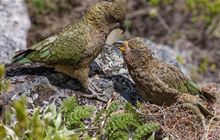Research on repellents to keep kea safe
Archived content: This media release was accurate on the date of publication.
Introduction
New research to test the use of repellents to help keep kea safe during predator control operations is underway near Arthur’s Pass in Canterbury.Date: 13 May 2022
The Department of Conservation and OSPRI (TBfree) are funding the research, which will test the effectiveness of two bird repellents (d-pulegone and anthraquinone) in reducing the risk of kea interacting with 1080 baits.
Kea are a taonga for Ngāi Tahu and Ngā iwi o Te Tau Ihu (northern South Island iwi) and valued by New Zealanders as an icon of the outdoors. However, this brainy parrot is in trouble, with predators such as stoats, possums and feral cats a major cause of their decline.
The aim of the research is to mitigate risk to kea and increase benefits from predator control for kea recovery, says DOC Science Advisor Kerry Weston.
“Evidence shows kea rear more chicks and survive in greater numbers after predator control operations but in some areas, there is a risk of kea eating 1080 baits, especially where birds have learnt to scrounge human food.
“Arthur’s Pass is one of the places where kea regularly interact with people and scavenge, putting them at higher risk, which is why we’re doing this research here.
“Previous trials with these repellents have shown promise but we need robust evidence to show they work to reduce the risk to kea without compromising the effectiveness of predator control itself.
“We’ve completed trials with a peppermint-flavoured additive, d-pulegone, in non-toxic cereal baits at 18 alpine sites and have seen some interesting kea reactions, although results have yet to be analysed.”
If the d-pulegone works to sufficiently repel kea and passes tests with rats and possums to ensure they will still eat the bait, it will be later trialled in a predator control operation. A new method using tiny capsules of repellent in the bait is being used to avoid previous evaporation problems.
Trials using anthraquinone will also take place as part of planned predator control operations later this year. This repellent makes birds feel temporarily sick and it will be used prior to operations to ‘teach’ kea to avoid 1080 baits. This method has been used with some success by ZIP (Zero Invasive Predators) in Predator Free South Westland and now warrants further testing in different environments.
The trials have been co-designed with Ngāi Tahu, OSPRI, ZIP and the Kea Conservation Trust, and build on previous research.
OSPRI’s Research Manager Richard Curtis welcomes the research and says he’s looking forward to seeing the results in coming months.
“Results from previous trials were encouraging, so I’m hopeful these trials will be too.
“Aerial pest control operations are necessary to protect the health of our cattle and deer herds from bovine TB. These operations also provide biodiversity benefits by suppressing predators such as possums and stoats, which threaten to decimate our native birds, including kea.”
Up to 100 kea will be monitored through the repellent trials and 1080 operations, using radio transmitters and video cameras, to assess their behaviour and ongoing survival over several years. In addition, 45 GPS trackers are being used, which show kea flight path data. They have already shown that kea move around far more than previously thought.
If the repellents prove successful, these methods would likely be added to DOC’s Code of Practice for use of 1080 in kea habitat.
All aerial 1080 operations in areas where kea live must follow the Code of Practice, which has measures to mitigate the risk to kea based on the latest research, including bait type, sowing rate, operation design and proximity to known kea scrounging areas.
Background information
- Kea outcomes from predator control
- Code of Practice for aerial 1080 in kea habitat (PDF, 200K)
- OSPRI update on kea repellent research in South Westland
Contact
For media enquiries contact:
Email: media@doc.govt.nz

